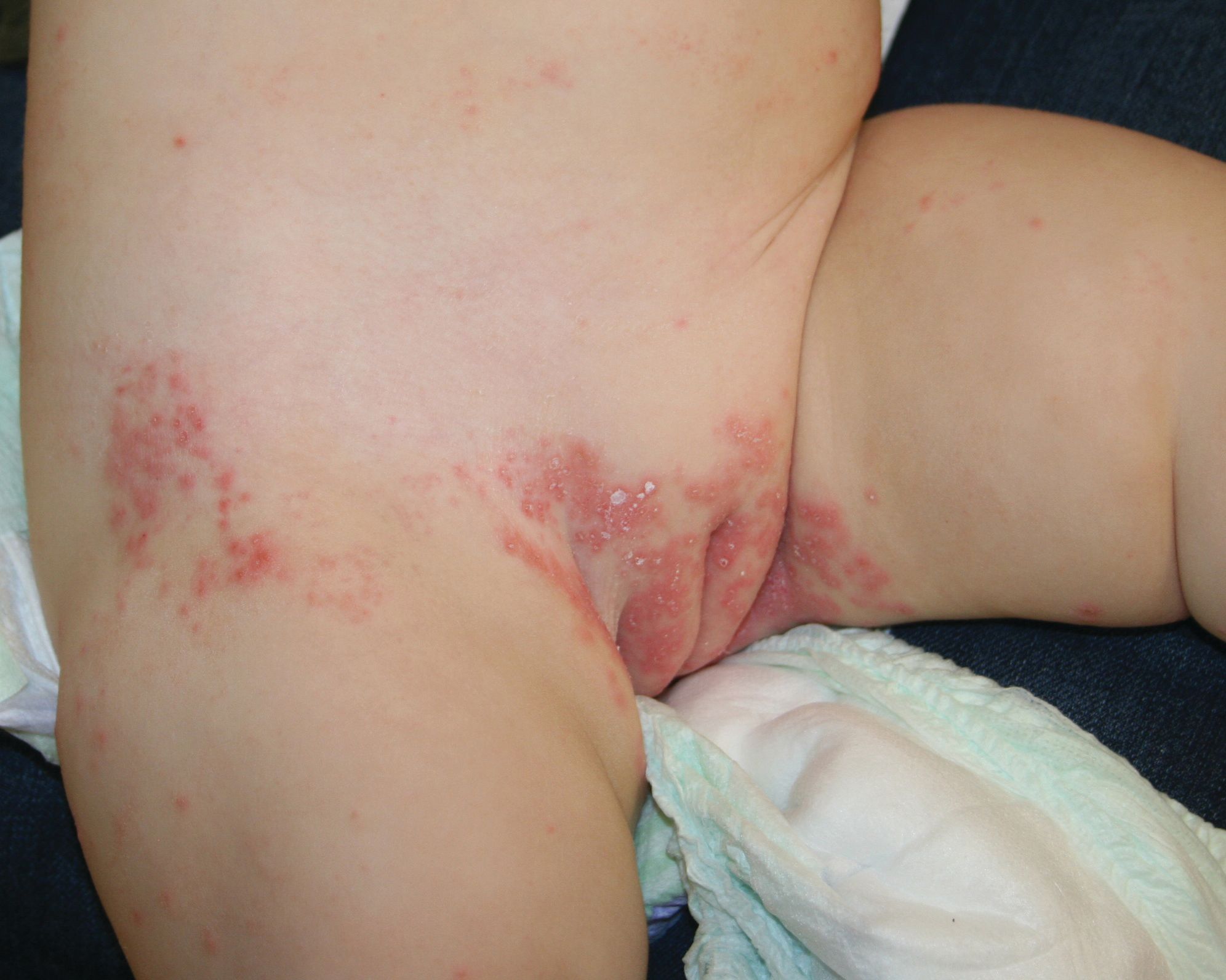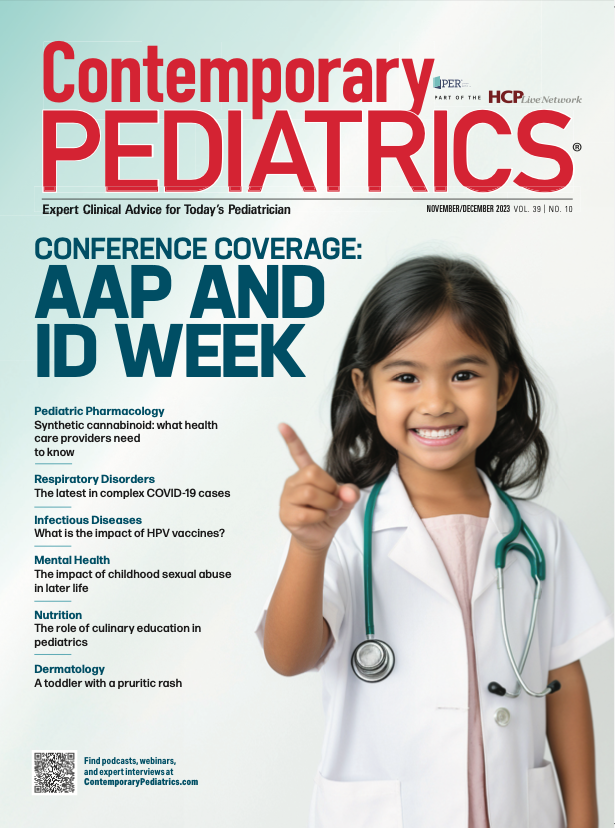A toddler with a pruritic rash
You are asked to evaluate a healthy 2-year-old girl who has developed a mildly pruritic rash with erythematous plaques, some with silvery-white scale, in the vulvovaginal area 3 months ago. What's the diagnosis?
(Figure 1) A toddler with a pruritic rash | Image credit: Author provided

You are asked to evaluate a healthy 2-year-old girl who has developed a mildly pruritic rash with erythematous plaques, some with silvery-white scale, in the vulvovaginal area 3 months ago (Figure 1).
She has had no vaginal discharge or other symptoms. The rash is now more widespread, and new lesions recently have appeared on the lower back and thighs.

Discussion
Psoriasis is a common, genetically determined chronic skin condition found in at least 2% of the population.1 Both genetic and environmental factors interact to precipitate the development of psoriasis.2 A family history of psoriasis is seen in 25% to 71% of patients with the disease.2
Environmental factors that can trigger the development of psoriasis in children include physical injury to the skin, stress, low humidity, and cold weather. Initiating factors in children can include viral and bacterial infections and some medications.2
Psoriasis affects both children and adults. All forms of psoriasis that are recognized in adults are encountered in childhood (plaque, guttate, erythrodermic, and pustular).The most frequently observed variants of psoriasis in children are the plaque type (especially localized to the flexural areas) and guttate psoriasis, which may be associated with juvenile psoriatic arthritis.2
In infantile psoriasis, the diaper area is commonly involved (referred to as napkin psoriasis) and is usually the first site of plaques triggered by a Köbner response because of constant irritation and maceration.2 Moreover, in infants, psoriatic plaques often lack scale.2
Vulvar psoriasis is a chronic inflammatory skin disorder that may be isolated or occur in conjunction with psoriasis elsewhere.3 Vulvar/anogenital psoriasis is one of the most common manifestations of psoriasis in young girls, and diagnosis can usually be made clinically without a biopsy.3
Differential diagnosis
Vulvar erythema associated with a rash can be associated with several inflammatory and infectious skin disorders3 including psoriasis, atopic dermatitis, contact irritant dermatitis, contact allergic dermatitis, lichen planus, lichen simplex chronicus, candidiasis, and tinea.
Candidiasis and tinea can be excluded with dermoscopy, potassium hydroxide preparations, and cultures.3
Lichen simplex chronicus is a more severe form of lichenoid dermatitis, which appears in individuals with atopic dermatitis and lacks the well-demarcated border of psoriasis.1 Interestingly, in infants and toddlers with atopic dermatitis, the diaper usually protects the skin from scratching, and atopic dermatitis does not usually appear in the buttocks or genital area until they are toilet trained and no longer wearing diapers.
Intermittent symptoms may be a clue for the diagnosis of allergic contact dermatitis,4 which may spread to involve the entire body surface, including the scalp.2 Severe pruritus is a cardinal symptom.2 Allergic contact dermatitis in the vulvovaginal area is common in adult women but uncommon in children.4
With psoriasis, physical examination results and the patient’s medical history are often sufficient to make the diagnosis,3 so it is important to inquire about family history. Review of our patient’s family history revealed that the patient’s mother had a similar rash in the genital area that spread to the trunk and proximal extremities when she was an adolescent, which from biopsy findings showed characteristics of psoriasis.
Critical questions when evaluating a patient with vulvar erythema
Timing. Acute vulvar erythema could indicate an allergic contact dermatitis or candidal vulvovaginitis.3 Chronic vulvar erythema suggests atopic dermatitis in older children and adults, seborrheic dermatitis in infants, psoriasis, or lichen simplex chronicus.3 However, chronic skin diseases can have acute flares.3 Irritant contact dermatitis may also be chronic if there is repeated use of irritating substances.3
Pruritus. Vulvar atopic dermatitis, allergic contact dermatitis, and candidal vulvovaginitis are generally very pruritic.3 Poor hygiene could be another cause of vulvar erythema with pruritus.3
History. The clinician should investigate any previous use of feminine hygiene products that could have led to irritation and erythema and could have provoked irritant contact dermatitis.3
In addition, any home remedies or medications used for the rash prior to the visit and the response/lack of response to them should be reviewed.3 Also, skin lesions elsewhere on the body and systemic symptoms should be investigated.3
Treatment
Low-potency to midpotency topical corticosteroids are recommended as first-line management of genital psoriasis.5 They are typically used for exacerbations twice a day for 1 to 2 weeks.
Moisturizers and emollients may be helpful in infantile psoriasis and can also be used in older children and adults.5 Once under control, nonsteroidal anti-inflammatory topical agents such as calcipotriol, anthralin, tacrolimus, tazarotene, and newly approved roflumilast (approved for individuals 6 years or older) and tapinarof (not yet approved in children) can be applied.
Systemic therapy is required in a minority of patients with severe, recalcitrant psoriasis1-3 and is not often used for isolated vulvar lesions.3 Systemic agents used to manage widespread psoriasis include retinoids (acitretin), immunosuppressants (methotrexate, cyclosporine, mycophenolate mofetil), and the new biologic agents.3 Treatment should be individualized to the patient’s age and the extent, distribution, symptoms, and type of psoriasis.2
Good hygiene and reduction of friction are important first-line measures for managing genital psoriasis.5 Patients should be advised to use gentle, nonsoap cleansers for the genitals and wear loose-fitting clothing to avoid further irritation.5
Vulvar psoriasis can have a significant impact on quality of life, and it must be recognized and managed.1 The clinician should explain to the patient that the disease can be managed but not cured.
Our patient
Treatment with low-potency topical steroid triamcinolone 0.025% ointment applied sparingly twice a day for 1 week was initiated and showed dramatic improvement, resulting in the clearance of the rash. It was then tapered over the next 2 weeks to as-needed, intermittent use.
The use of topical nonsteroids such as tacrolimus ointment was discussed as well but not chosen as therapy at this time.
For more from the November/December issue of Contemporary Pediatrics, click here.
References:
1. Kapila S, Bradford J, Fischer G. Vulvar psoriasis in adults and children: a clinical audit of 194 cases and review of the literature. J Low Genit Tract Dis. 2012;16(4):364-371. doi:10.1097/LGT.0b013e31824b9e5e
2. Janniger CK, Schwartz RA, Musumeci ML, Tedeschi A, Mirona B, Micali G. Infantile psoriasis. Cutis. 2005;76(3):173-177.
3. Trager JDK. What’s your diagnosis? well-demarcated vulvar erythema in two girls. J Pediatr Adolesc Gynecol. 2005;18(1):43-46. doi:10.1016/j.jpag.2004.11.009
4. Pichardo-Geisinger R. Atopic and contact dermatitis of the vulva. Obstet Gynecol Clin North Am. 2017;44(3):371-378. doi:10.1016/j.ogc.2017.05.003
5. Beck KM, Yang EJ, Sanchez IM, Liao W. Treatment of genital psoriasis: a systematic review. Dermatol Ther (Heidelb). 2018;8(4):509-525. doi:10.1007/s13555-018-0257-y
Newsletter
Access practical, evidence-based guidance to support better care for our youngest patients. Join our email list for the latest clinical updates.
